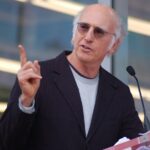Blog Post
The aborted children of Western civilization’s famous writers
By Jonathon Van Maren
“Abortions will not let you forget,” Pulitzer Prize-winning poet Gwendolyn Brooks wrote sadly in her poem the mother, “You remember the children you got that you did not get, The damp small pulps with little or with no hair…I have heard in the voices of the wind the voices of my dim killed children.” Her words could be a lament for all the lost children of the literary elites, many of whom died at the behest of the storytellers we love the best so that the titans of literature could realize their ambitions. The list is seemingly endless. As I wrote in my essay “How abortion changed America’s literary landscape,” John Steinbeck forced his first wife into an abortion, F. Scott Fitzgerald’s second child was aborted, and Jack Kerouac lost at least one child to abortion. So did many of our most well-known poets and songwriters. Children were cruelly snuffed out by abortion, and their mothers often suffered horribly in their wake.
Perhaps the playwright George Bernard Shaw summed up the tragedy of the unwanted children and maltreated women of the literary class most succinctly in Man and Superman, where he described artists in chilling terms: “To women he is half vivisector, half vampire. He gets into intimate relations with them to study them, to strip the mask of convention from them, to surprise their inmost secrets, knowing that they have the power to rouse his deepest creative energies, to rescue him from his cold reason, to make him see visions and dream dreams, to inspire him, as he calls it. He persuades women that they may do this for their own purpose whilst he really means them to do it for his. He steals the mother’s milk and blackens it to make printer’s ink to scoff at her and glorify ideal women with. He pretends to spare her the pangs of child-bearing so that he may have for himself the tenderness and fostering that belong of right to her children. Since marriage began, the great artist has been known as a bad husband. But he is worse: he is a child-robber, a blood-sucker, a hypocrite, and a cheat. Perish the race and wither a thousand women if only the sacrifice of them enable him to act Hamlet better, to paint a finer picture, to write a deeper poem, a greater play, a profounder philosophy!”
George Bernard Shaw’s words were autobiographical. When he was already 65-years-old, he began an affair with a young American actress in her twenties, Molly Tompkins. Despite the fact that she was married to the American sculptor Lawrence Tompkins, Shaw was obsessed with her, teaching her how to dress elegantly, behave socially, and speak precisely. Their relationship continued until the 1930s in both London and Italy, with Tompkins referring to Shaw as her “Sunday husband,” and Shaw reportedly loved her until he died in 1950. He was preceded in death, Tompkins’ son Peter revealed years later, by a child who died at the hands of an abortionist in Milan—a child the playwright and the actress had conceived together. Shaw had no other known children, and left us only his written works.
Shaw’s friend and rival H.G. Wells, the “father of science fiction,” had many mistresses, but perhaps the most fascinating of them was Moura Benckendorf (also known as Moura Budberg), who worked as Russian writer Maxim Gorky’s interpreter. She herself was infamously promiscuous, throwing massive parties at the estate of her Estonian aristocrat husband while he was off fighting in the First World War and carrying on with British master spy Robert Bruce Lockhart. She began an affair soon after meeting Wells, and he was purportedly very disturbed when she wrote to inform him that she would only be able to join him for two of the four weeks they had planned for a getaway in North Wales because she had become pregnant with his child and had arranged an abortion.
The French philosopher and literary renaissance man Jean Paul Sartre lived Shaw’s words to the hilt. While championing the idea of open relationships with his feminist bedmate Simone de Beauvoir, he lied relentlessly to the string of women who passed through his bedroom while Beauvoir looked on with bemusement and pity. Women threw themselves at him, crashed, burned, and had their babies killed to appease him. Sometimes they killed themselves, too. He financed the abortion of one mistress, and the poet Michelle Vian, who divorced her husband for Sartre, had three abortions during their relationship. Eventually, their love died, too. Abortion, of course, was still illegal in France, and it was Beauvoir who authored the Manifesto of the 343, a petition of civil disobedience signed by 343 women who claimed that they’d had illegal abortions that was published in Le Nouvel Observateur on April 5, 1971. This petition paved the way for the “Veil law” in January 1975, which repealed the penalty for having an abortion during the first ten weeks of gestation. (Despite being a signatory, most historians argue that Beauvoir herself never had an abortion.)
It was horrifyingly common for tiny children to get strangled in the complex sexual entanglements of their literary parents. The prominent New Zealand short story writer Katherine Mansfield had an abortion in the spring of 1911, shortly after leaving her husband. Jean Rhys, who wrote her 1966 novel Wide Sargasso Sea as a prequel to Charlotte Brontë’s Jane Eyre, had an abortion after sinking into prostitution and alcoholism prior to her writing career. Eric Ambler, the spy novelist, borrowed 16 guineas from his uncle to finance the abortion of his child after an affair with a married woman. E.E. Cummings’ wife Anne Barton had an abortion in New York just after he left for the Soviet Union in 1933 after failing to find an abortionist in Paris. Three of V.S. Naipual’s children were killed by abortion, and he was such an awful man that Saul Bellow remarked that “after one look from him, I could skip Yom Kippur.” Bellow’s wife had an abortion after having an affair with his close friend Jack Ludwig right under his nose. When Bellow found out, he wanted to shoot him, but was physically restrained by a friend who told him to instead “be a mensch, have an ulcer” instead.
According to biographer Lewis M. Dabney, the American writer Edmund Wilson, who influenced F. Scott Fitzgerald, told his daughter Helen that he “hated abortions” because he’d gone through a number of them himself. The Romanian novelist Norman Manea summed up the love affairs of his youth with a short, bloody sentence: “There were abortions, too.” British playwright John Osborne’s first wife Pamela Lane had an abortion in 1956 after an affair. The English novelist Keith Waterhouse, who died at age 80 in 2009, was described as “a monster” by his former girlfriend Jean Leyland, who says that he demanded she abort both of the children they conceived together. Scottish writer Alexander Trocchi abandoned his young wife Betty in Paris for the beautiful Jane Lougee, who was conveniently the daughter of a Maine banker who financed his magazine, Merlin. Despite leaving Betty and his two little daughters to struggle along as best they could while he realized his literary ambitions, he still occasionally paid Betty conjugal visits—but ensured that the two resulting pregnancies ended in abortions.
The same was true for the Welsh poet Dylan Thomas, who wrote the magnificent lines of poems such as Do not go gentle into that good night. After marrying his wife Caitlin in 1937, the couple lived a booze-fuelled lifestyle occasionally interrupted by infidelity and generally characterized by savage selfishness. They turned out to be an extraordinarily fertile couple, and as such they decided to scrape together the money to have their offspring scraped out of Caitlin’s womb in a string of illegal abortions that proved to be extremely expensive. Although they eventually had three children together, Thomas’s bohemian lifestyle resulted in his premature death at the age of 39 years old in 1953. When his wife was informed that he had taken ill in America so she could fly to his bedside, her reported first words upon arrival at the hospital were “Is the bloody man dead yet?”
Even royal blood could be shed in the sexual wargames that the elites loved to play. The father of British dramatist Terence Rattigan, the diplomat Frank Rattigan, had an affair with Princess Elisabeth of Romania (who would later become the consort of King George II of Greece) which resulted in Terence’s half-sibling being aborted. In the 1930s, the French poet Jean Cocteau had an affair with the beautiful Princess Natalie Paley, an actress, model, and daughter of a Romanov grand duke. The princess became pregnant, and had an abortion. Cocteau was devastated, and Paley reportedly regretted the loss of their child for the rest of her life. On the other hand, many of the artistic elites were positively casual about abortion—Peggy Guggenheim had seven abortions, which she discussed freely. The British novelist and poet Lawrence Durrell, who had his artist wife Nancy have an abortion, told the nursing staff who offered to show him the aborted baby to “shove it up their arse.” When the couple eventually split, Nancy took their only surviving daughter with her.
It is the forced abortions that highlight the cruelty of so many men so vividly. Rosamond Lehmann, a novelist who later ran with the Bloomsbury set, was forced into an abortion she didn’t want by her first husband. She left him afterwards. Comedy writer Kingsley Amis boasted to Phillip Larkin in a January 1948 letter that he had worn down his 19-year-old girlfriend Hilly’s sexual resistance, but when she became pregnant, he promptly found an abortionist and gave “the nasty man” a hundred pounds to do the job, announcing that he didn’t “want this filthy baby.” When a friend told Kingsley that Hilly might be rendered sterile or killed by the procedure, he cancelled it and proposed to her instead, and they had three children—but he forced her to have an abortion when she became pregnant with their fourth child, which would have been the younger sibling of novelist Martin Amis. One wonders, too, if the alcoholic gonzo journalist Hunter S. Thompson was deadly serious when the journalist Lynn Carey Knight-Ridder asked him during a drug-laced interview if he was “a grandpa yet.” Thompson was emphatic: “No! No I’m not. I forced my son’s wife to have several abortions.” An “author escort” assigned to oversee Thompson’s interviews and prevent such revelations inserted herself a split second too late: “You can’t print that.”
Arthur Koestler, the volcanic anti-Stalinist who shot to international fame with the publication of his 1940 anti-totalitarian novel Darkness at Noon and a host of other biographies, novels, and essays, was also a brute. Although his devotees prefer to refer to “stormy personal relationships,” the blunt fact is that he was violent and abusive to his wives and girlfriends, and in at least one case he was probably guilty of rape. He was a man of utter selfishness, as totally faithless towards his romantic partners as he was devoted to himself, and he despised the idea of fatherhood and children so much that he forced several lovers into illegal abortions to ensure that those he sired would never meet him. One of these unfortunate women was the novelist Elizabeth Jane Howard, who had an abortion after being impregnated by Koestler in 1955. He refused to meet the one child that did survive, and eventually killed himself with his third wife on March 1, 1983. Perhaps prophetically, he had in his later years championed voluntary euthanasia.
The literary elites have always been plagued by whispers of abortions and children that might have been. In Miranda Seymour’s hefty biography Mary Shelley, she notes that infidelity, suicides, and tragedy were common in the life of the author of Frankenstein. As Claude Rawson put it in the New York Times: “It is possible that her stepsister Claire Clairmont was pregnant by Percy Bysshe Shelley, Mary Shelley’s husband, and that the child was aborted or miscarried. Births and deaths coexisted violently in Mary’s world. Her mother had twice attempted suicide during her unhappy affair with her lover, Gilbert Imlay. Their child, Mary’s half sister Fanny, did commit suicide, perhaps out of love for Percy Bysshe Shelley. His first wife, Harriet, killed herself while pregnant. Byron’s friend John Polodori, an admirer of Mary Shelley, committed suicide too.” It was the carnage left in the wake of the gallivanting sexual freebooters that led Shelley to cry out, “God save me from the freethinkers!”
Even stranger is the case of Gore Vidal, the infamously libertine gay writer who occasionally dabbled in heterosexuality when he was a young man. Fred Kaplan writes that he had an affair with a waitress in Key West in the early 1950s—and according to the young woman, Vidal got her pregnant. The historian and novelist Louis Auchincloss hastily advised Vidal to send the girl the $780 required to procure an abortion, and Vidal was later told that a doctor had done the job. The story, however, got around, and one of Vidal’s enemies actually spread a rumor that the doctor who had performed the abortion “had a Christmas tree, and on it was a fetus and he said that’s Gore Vidal’s child.” In 2008, however, Robert Chalmers asked Vidal about the abortion in an interview for The Independent: “There are rumors that you have a daughter from a relationship with a woman living in Key West, Florida [in the 1950s]; are they true?” Vidal was dismissive: “Possibly. I don’t believe so. The father was either me or a German photographer. I believe the mother is dead. The child was a girl. Every Christmas, I would receive a picture of them all around the tree, and there’s the little girl, looking like me. I could have a daughter, yes.” When Chalmers asked if he’d tried to contact her due to the possibility that he was the father, Vidal replied firmly that he had not: “I sent her mother money for an abortion. Which she used to go to Detroit, where she found a rich man.”
Erich Maria Remarque, the man who wrote the gripping Great War account All Quiet on the Western Front, fled Germany for Switzerland and subsequently America after Hitler seized power and Goebbels banned his books. Despite being both Catholic and married, Remarque made his way through a string of women and wined and dined with the elites, remaining unaware of the tragic suffering his family was enduring in Nazi Germany. His father’s second wife killed herself, his brother-in-law became a prisoner of war, and his sister Elfriede Scholz, a Dresden fashionista dressmaker, was turned in to the Gestapo for “defeatist talk.” She was sentenced to death in one of the Nazi kangaroo courts and beheaded, and the reported words of the judge would haunt Remarque all his life: “We have sentenced you to death because we cannot apprehend your brother. You must suffer for your brother.” As Remarque fornicated relentlessly with everyone from common prostitutes to the stars of the silver screen like Greta Garbo, Hedy Lamarr, and Marlene Dietrich, there has long rumored to have been one other casualty in the Remarque family: Many believe that the stunning Irish-American actress Maureen O’Sullivan (best known for playing Jane in the Tarzan films) aborted Remarque’s only child.
The millions of missing children, whose lives were as brief and as soft as a sigh and died invisible, are the backdrop against which much of our modern culture has been built. The blood of unwanted sons and daughters was for many great writers, poets, and songwriters an essential ingredient in the building of their literary legacies, the artists who in so many cases sold their souls to create fleeting beauty and became, as George Bernard Shaw coldly puts it, “half-vampire.” Many of them lived nursing the secret sorrows of who could have been, and perhaps this is what the pro-choice (and Pulitzer Prize-winning) poet Sharon Olds was referring to in her haunting poem The Unborn:
Sometimes I can almost see, around our heads,
Like gnats around a streetlight in summer,
The children we could have,
The glimmer of them.
Sometimes I feel them waiting, dozing
In some antechamber – servants, half-
Listening for the bell.
Sometimes I see them lying like love letters
In the Dead Letter Office
And sometimes, like tonight, by some black
Second sight I can feel just one of them
Standing on the edge of a cliff by the sea
In the dark, stretching its arms out
Desperately to me.









I believe that these people are monsters. I don’t care what greatness they may have tough they were.2
I pray that God will have mercy on them .